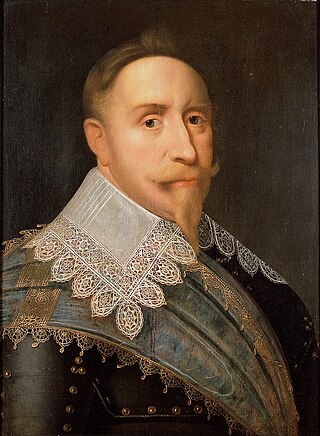Deaths
| | This section needs expansion. You can help by adding to it. (July 2015) |
| Years in Sweden: | 1623 1624 1625 1626 1627 1628 1629 |
| Centuries: | 16th century · 17th century · 18th century |
| Decades: | 1590s 1600s 1610s 1620s 1630s 1640s 1650s |
| Years: | 1623 1624 1625 1626 1627 1628 1629 |
Events from the year 1626 in Sweden
| | This section needs expansion. You can help by adding to it. (July 2015) |

Gustav IV Adolf or Gustav IV Adolph was King of Sweden from 1792 until he was deposed in a coup in 1809. He was also the last Swedish monarch to be the ruler of Finland.

Charles XIII, or Carl XIII, was King of Sweden from 1809 and King of Norway from 1814 to his death. He was the second son of King Adolf Frederick of Sweden and Louisa Ulrika of Prussia, sister of Frederick the Great.

The monarchy of Sweden is centered on the monarchical head of state of Sweden, which is a constitutional and hereditary monarchy with a parliamentary system. There have been kings in what now is the Kingdom of Sweden for more than a millennium. Originally an elective monarchy, it became a hereditary monarchy in the 16th century during the reign of Gustav Vasa, though virtually all monarchs before that belonged to a limited and small number of families which are considered to be the royal dynasties of Sweden.
An heir apparent, sometimes femininely heiress apparent, frequently heir, is a person who is first in an order of succession and cannot be displaced from inheriting by the birth of another person. A person who is first in the current order of succession but could be displaced by the birth of a more eligible heir is known as heir presumptive.

Count Gustav Horn af Björneborg was a Finnish nobleman of the Swedish Empire, military officer, and Governor-General. He was appointed member of the Royal Council in 1625, Field Marshal in 1628, Governor General of Livonia in 1652 and Lord High Constable since 1653. In the Thirty Years' War (1618–1648), he was instrumental as a commander in securing victory at the Battle of Breitenfeld, in 1631. He was High Councillor of the realm in 1625, elevated to the rank of field marshal in 1628, and sometimes commander-in-chief of Swedish forces in Germany during Thirty Years' War. After the war, he served as Governor-General of Livonia 1652, President of War department and Lord High Constable in 1653. In 1651, Queen Christina created him Count of Björneborg.
The Polish–Swedish wars were a series of wars between the Polish–Lithuanian Commonwealth and Sweden. Broadly construed, the term refers to a series of wars between 1563 and 1721. More narrowly, it refers to particular wars between 1600 and 1629. These are the wars included under the broader use of the term:

Gustavus Adolphus, also known in English as Gustav II Adolf or Gustav II Adolph, was King of Sweden from 1611 to 1632, and is credited with the rise of Sweden as a great European power. During his reign, Sweden became one of the primary military forces in Europe during the Thirty Years' War, helping to determine the political and religious balance of power in Europe. He was formally and posthumously given the name Gustavus Adolphus the Great by the Riksdag of the Estates in 1634.

Events from the year 1809 in Sweden

Events from the year 1789 in Sweden

Events from the year 1771 in Sweden

Events from the year 1520 in Sweden.

Events from the year 1535 in Sweden

Events from the year 1631 in Sweden

Events from the year 1628 in Sweden

Events from the year 1632 in Sweden.

Events from the year 1644 in Sweden
Events that occurred during the year 1624 in Sweden, including births and deaths.

Events from the year 1630 in Sweden

Events from the year 1620 in Sweden

Events from the year 1622 in Sweden